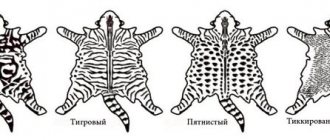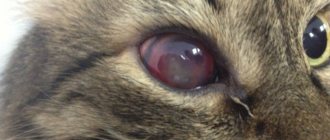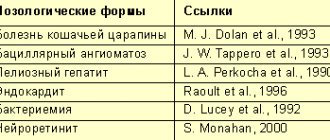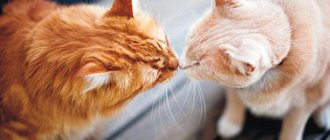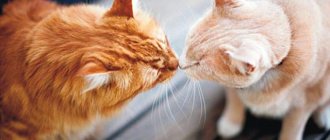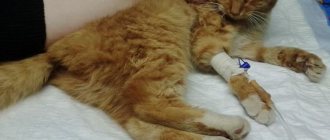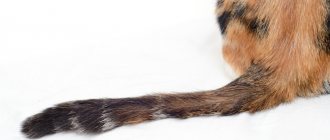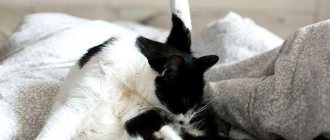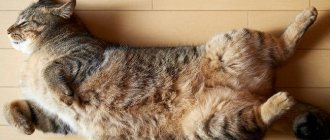Careless movements, increased physical activity and mild injuries can affect a cat's dislocation. Damage can be diagnosed in the shoulder, neck, leg or thigh muscles. It is possible to determine that an animal has a twisted front or back leg by the cat’s restless behavior, limping, decreased activity and other symptoms. Dislocation of the jaw and other movable structures requires contacting a veterinarian, who will determine the causes of the deviation, assess the severity and select treatment.
Main reasons
Dislocation of the elbow joint or hind leg in a cat can be congenital or acquired. In the first case, the damage is explained by a genetic factor and more often in a pet the hip joint is disrupted or the wrist joint is damaged. Congenital stretch marks appear in kittens as early as 6 months of age.
Felinologists note that Himalayan, Persian and Maine Coon cats are at risk of developing congenital dislocations of the shoulder and elbow joints.
If a kitten or adult has sprained its paw throughout its life, then this phenomenon is often the result of an injury of varying severity. Mechanical impact can damage not only joints, but also rupture of ligaments and muscles. A bruised paw is often the result of careless handling of the cat by owners. Some owners may show aggression towards their pets or accidentally cause mechanical damage to the animal, after which it may suffer a dislocated leg or sprain. The following reasons can affect acquired dislocations:
An animal can get this injury if it plays too actively.
- Chronic diseases: rickets;
- osteoporosis;
- osteomalacia;
- arthritis;
- arthrosis of the shoulder and other joints.
Operation for advanced cases
Surgery is necessary for advanced or complex dislocations.
After receiving an injury, the dislocation must be corrected as soon as possible. Delay in receiving medical help leads to muscle contraction, the formation of a dense blood clot and scar tissue. These changes make it difficult to reduce the dislocation using a closed method. In such cases, the question arises about surgical treatment of advanced dislocations.
During the operation, during which the animal is asleep, an incision is made in the joint area, through which fibrin clots and destroyed parts of the joint are removed. The joint returns to its original position; this will require force or special levers. A joint reduced openly also requires fixation and temporary immobilization.
Sometimes a cat requires surgical fixation of a joint:
- for dislocations of the hip or wrist joints, it is carried out using special pins;
- for elbow and ankle - screws and wires.
Congenital dislocations in furry pets are usually eliminated using the open method. After a minor dislocation, the animal recovers within 3-4 days. The cat can use its paw, but has a slight limp. Full recovery from severe dislocations takes about 3-4 weeks.
What species are found?
Features of tail dislocation
Kittens and adults often receive this type of injury during fights with other felines, dogs, and other possible enemies. A cat's tail can be damaged due to a collision with a car. It is not uncommon for the tail to become dislocated due to the owner carelessly stepping on it or being pinched by doors.
Damage to the hip joint
A fluffy's injured paw visually looks shorter than a healthy one.
The cat quite often twists this type of movable joints, which is associated with increased load on the round ligament. If there is a violation, the head of the femur is everted out of the anatomical cavity. Dislocation of the hip joint in cats provokes noticeable lameness and severe pain with the slightest movement. The size of the damaged hind paw is noticeably different from the front one, since the first one becomes shorter.
Sprained paws on a cat
If a pet has twisted its front paw, then the clinical picture is very similar to a dislocation of the hip joint. It is painful for a kitten and an adult to step on an injured limb, which is why it moves with a limp. If a sprain appears in the area of the front or hind limb, it is better for the owners to contact a veterinary clinic immediately without trying to treat them on their own or try to straighten the dislocated joints.
Characteristic symptoms
In kittens and adults, dislocation of the lower jaw and other movable joints rarely goes unattended, since the disorder is often accompanied by a more pronounced clinical picture. Symptoms may vary depending on which movable structure the cat has dislocated. The main localization of damage and features of clinical signs are presented in the table:
| Location | Symptoms |
| Hip joint | Pain when moving |
| Lameness or inability to walk independently | |
| Swelling and swelling | |
| Shortening of the injured limb | |
| Clicking or crunching sound when moving | |
| Tail | Noticeable curvature |
| Rare tail movements | |
| Front or hind legs | Injury leads to decreased physical activity |
| Disturbed gait | |
| Attempts to move on 3 legs due to severe pain | |
| Deformation processes | |
| Jaw | Swelling in the mouth area |
| Difficulty eating due to pain | |
| Asymmetry of the upper jaw in relation to the lower jaw | |
| Protrusion of displaced bone |
If a cat has torn a tendon or severely dislocated a joint, then hematomas appear on the damaged area, signaling subcutaneous hemorrhage.
Rehabilitation period
How long the recovery phase will last depends on the severity of the fracture, the general condition and age of the cat. In young individuals, it usually lasts three weeks, with a maximum of 30 days. In an old cat, the healing process is longer - 35-40 days.
To monitor proper fusion of the bone structure, your pet should be taken to a veterinary surgeon for a monthly check-up.
In order to restore the motor function of the damaged limb, elasticity and muscle tone, manual massage should be performed, the technique of which will be introduced by the veterinarian. Daily massage procedures stimulate blood circulation, healing of periosseous tissues, and accelerate the process of bone fusion.
A cat's diet should be balanced, nutritious and easily digestible. The animal needs foods enriched with phosphorus and calcium. However, we must remember that an excess of these components often leads to the formation of stones in the gall bladder and kidneys.
Vitamin and mineral supplements will also help speed up your pet's recovery, but they can only be given after consultation with a specialist. The veterinarian prescribes vitamins based on the animal’s needs.
How is diagnosis carried out?
If an animal has harmed itself, it must be examined by a doctor during a mandatory visit to the clinic.
If your cat suspects a dislocation, you should immediately contact a veterinary clinic. The specialist will examine the pet and find out from the owners under what circumstances the damage occurred. An examination is required to assess the extent of the injury and its exact location. When a cat has a dislocation, it is imperative that an x-ray is taken, thanks to which all damaged areas are noticed and the condition of the ligaments and tendons is determined.
Providing emergency assistance by the owner
In case of traumatic damage to a joint, veterinary specialists strongly do not recommend self-medication and resetting the dislocation of the animal. This can lead to unpleasant consequences and complications. Having discovered a joint dysfunction in a cat, the owner can take the following measures before providing qualified assistance:
- Immobilize the injured limb. To immobilize the joint, planks and a short ruler are suitable.
- Place the animal in a limited space: box, carrier, basket. The cat should be kept inactive. You should not touch the sore paw, causing discomfort to your pet.
- In the first half hour, applying a cold object to the site of injury is effective. For these purposes, wrap something from the freezer in a towel. Cold acts as a pain reliever and reduces swelling when a joint is damaged.
- When reducing a dislocation, the animal is usually put into a narcotic sleep, so it is better not to feed the pet before the visit to the clinic.
The owner’s task is to immediately deliver the injured cat to a specialized facility. Delay threatens scarring of damaged tissues and the inability to reduce.
What to do and how to treat the animal?
Reduction in a veterinary clinic
The sooner your pet receives help for a dislocation, the less likely it is to develop complications. The veterinarian performs closed reduction of displaced mobile structures, which is carried out under x-ray guidance. Since the manipulation is painful, it must be done under general anesthesia. During the procedure, muscle relaxants may also be required, the effect of which is aimed at relaxing the cat’s muscles. After the reduction of the dislocation is completed, a fixing bandage is applied, which the pet wears for 2 weeks. If the hip joint has moved out of place, then its restoration, in most cases, requires surgical intervention using surgical wires.
Performing an operation: when is it necessary?
In advanced situations, the animal has to undergo surgery.
Surgical treatment is required for advanced dislocations that were not detected and treated immediately, as a result of which scars began to form on the tissues. As contracture progresses, fusion of bone structures or resection of the mobile joint is required. In case of dislocation, various types of operations can be performed, such as:
- closed reduction using a pin;
- open reduction, which involves suturing the capsule;
- endoprosthetics;
- corrective osteotomy.
Conservative treatment
In case of a slight dislocation in a cat, a reduction is performed, after which it is necessary to take chondroprotectors and medications that eliminate the inflammatory reaction. For some time after the injury, the pet experiences pain of varying intensity, which can be managed with the following painkillers:
- "Ketofen";
- "Nalbuphine";
- "Butomidor."
Treatment
The doctor develops a further treatment plan based on the examination picture, including x-ray.
If surgical intervention is necessary, blood (fibrinous) clots and parts of damaged tissue are removed from the site of joint damage. Using special instruments, the head of the joint is returned to its normal position. The affected limb is fixed and immobilized for at least 10 days. If the disease progresses well, the recovery period lasts about a month.
During this period, the cat owner must comply with strict treatment regulations prescribed by a specialist. The postoperative period is usually accompanied by weakened immunity of the animal.
Therefore, in addition to regular examinations by a veterinarian, dressings and X-ray examinations, you will need to provide your cat with good care:
- Pay attention to proper nutrition (with the necessary content of vitamins and microelements) and the quality of feed;
- Monitor the cleanliness of the home and the hygiene of the cat’s equipment (feeding bowls, sleeping place), do not allow the animal in the entrance area of the house to come into contact with the owners’ outdoor clothing and shoes, in order to avoid infection;
- If there are small children in the house, you need to limit their interaction with the cat as much as possible in order to provide it with peace and relaxation;
- Give medications regularly, without missing a dose, and follow all procedures prescribed by your doctor.
Be sure to read:
A cat is limping on its front leg: what to do, causes, treatment methods, when it is not pathological
Mild joint dislocations require recovery of no more than 4-5 days, but this does not mean that the sick cat does not require attention.
